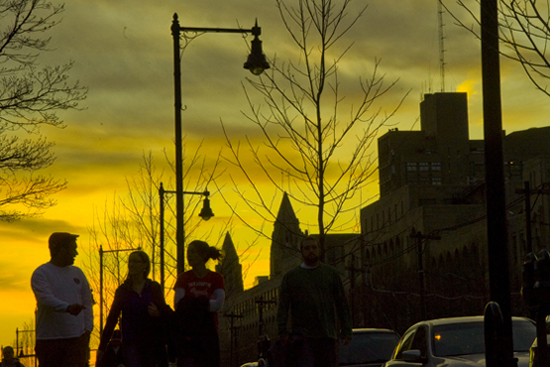Feeling SAD? You’re Not Alone
’Tis the season for seasonal affective disorder

Sunday at 2 a.m., the clocks were set back an hour, bringing an end to Daylight Saving Time and ushering in Eastern Standard Time. The change means the sun now sets before 4:30 p.m. And with the winter solstice just six weeks away, daylight hours are dwindling rapidly.
For some, fewer hours of daylight can lead to seasonal affective disorder, or SAD, a type of depression that sets in each year in late fall or early winter and abates as the days lengthen.
The good news is that there are effective treatments for the disorder.
Who’s at risk of developing seasonal depression? What are the symptoms? And what options are available for those who suffer from it? For answers to those and other questions, BU Today spoke with Sanford Auerbach, a School of Medicine associate professor of neurology and psychiatry and director of the Sleep Disorders Center at Boston Medical Center.
 BU Today: What is seasonal affective disorder (SAD)?
BU Today: What is seasonal affective disorder (SAD)?
Auerbach: The term refers to changes in mood and affect that correlate with seasonal changes. Most commonly, it is used to refer to depression associated with the months of late fall and winter.
What are the symptoms?
Symptoms may vary in intensity and combination across individuals, but usually include a decrease in energy and concentration, a decreased interest in work and social activities, a craving for carbohydrates, increased appetite and weight gain, an apparent increase in sleep need, social withdrawal, sluggishness, and a depressed mood.
How does a person know he or she has SAD? Is there a test that can diagnose the disorder?
The first, and most critical, step is to become aware of the presence of some or all of these symptoms. At times, this may require feedback from friends or colleagues. A loss of self-awareness and insight may accompany these symptoms. It is the correlation of the symptoms with seasonal changes that is key.
The next step is to seek an evaluation by a health care provider. In some respects, these symptoms are nonspecific and may also be triggered by other medical problems. Depending upon the extent of the mood changes, it may also be important to have a more extensive psychological assessment.
How many people suffer from SAD?
The incidence of SAD will vary according to the distance from the equator and seems to correlate with exposure to days with a short duration of sunlight. Although it has been estimated that 20 percent of those in the United States may suffer from some of the symptoms of SAD, perhaps 5 percent meet formal diagnostic treatment for the disorder. Furthermore, these figures may vary from slightly more than one percent in Florida to almost 10 percent in New Hampshire.
What treatment is available?
Many of the treatments used in the management of depression can be applied to the treatment of SAD. In particular, many of the commonly used antidepressant medications may be quite effective. Some have advocated alternative approaches, such as the use of daily doses of melatonin or vitamin D. The value of these less conventional options has not been as well established.
In addition, the use of bright light therapy has been studied more specifically and is usually accepted in the management of SAD. For most patients, light therapy is most effective when used early in the morning for about 20 to 30 minutes, but some patients also benefit when using the therapy at night.
Are some people more at risk than others for developing SAD?
In general, those with a tendency to develop depression are at an increased risk for SAD. Living in areas that are far from the equator will increase risk, particularly during the winter months.
Do many people with this disorder go undiagnosed?
Yes. Symptoms may vary in intensity and will start to resolve spontaneously as one passes through the days of shortened daylight hours. Hence, the symptoms may be starting to resolve by the time medical attention is sought. Also, as noted, the individual may often not have the insight to recognize the symptom profile.
Are there steps that can be taken to either prevent or mitigate the severity of SAD?
Early recognition is critical. Once the symptom profile is recognized, an effort should be made to optimize morning light exposure, especially during the winter months.
John O’Rourke can be reached at orourkej@bu.edu.

Comments & Discussion
Boston University moderates comments to facilitate an informed, substantive, civil conversation. Abusive, profane, self-promotional, misleading, incoherent or off-topic comments will be rejected. Moderators are staffed during regular business hours (EST) and can only accept comments written in English. Statistics or facts must include a citation or a link to the citation.